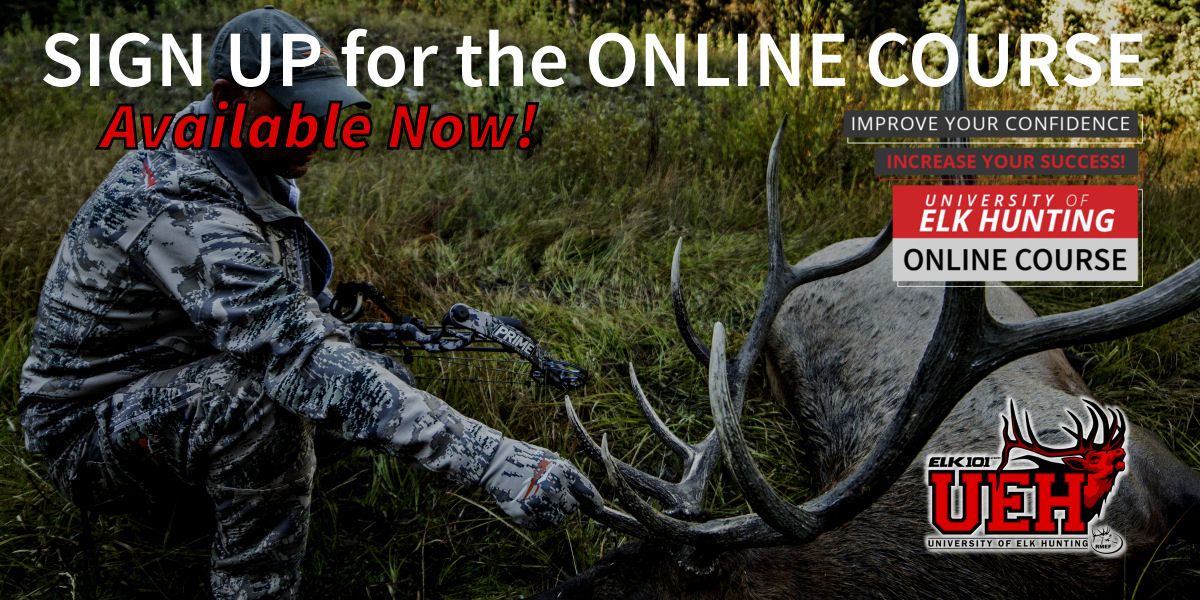Will the Online Course Make Me A Better Elk Hunter?

The original question that initiated the creation of the University of Elk Hunting Online Course was “What is the one thing you feel you need to improve most upon to become a more successful elk hunter?”. There were nearly 10,000 responses to that question, and the responses were quite varied. However, there were a few that were repeated most frequently. Those topics were:
- How do I scout for elk from home (Google Earth, etc.)?
- How do I learn to use elk calls better?
- How can I overcome the wind and get closer to elk?
In addition to those topics, I also feel the topic of elk anatomy and following the bloodtrail is super important. That is why I spent so much time dissecting an actual elk carcass, and taking precise measurements to recreate the anatomy diagrams for both broadside and frontal elk.
Since these 4 subjects made up over 75% of the questions I received regarding what elk hunters feel they need to improve upon to become more successful, I put a lot of effort into those topics when I created the Online Course. Here are some of the details that are covered in the course:
1. How do I scout from home (Google Earth)?
This is probably the most common question that has been presented to me in the past 5-6 years. If you haven’t yet read the last article on “Scouting Remotely With Google Earth” (https://www.elk101.com/2016/05/scouting-remotely-with-google-earth/) go read that. It will give you a quick glimpse into what I dive into in the Online Course. But there is so much more, and I cover all of that in the course. Within the course, I go into the following areas related to scouting:
- Using the Internet to gather information on an area
- Tapping into local resources for firsthand information
- Understanding how to read and use maps (identifying terrain features), and where to find the right maps
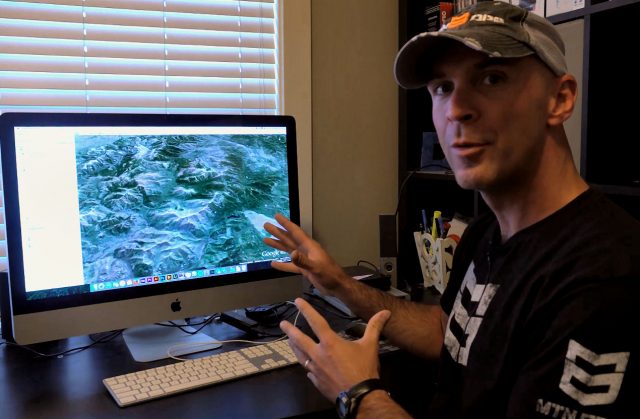 Using Fire Maps to monitor current and past wildfires (and their effects on hunting areas)
Using Fire Maps to monitor current and past wildfires (and their effects on hunting areas)- Other internet based resources for scouting
- Understanding important features within Google Earth (measuring distances, adding placemarks, setting imagery dates, etc.)
- Using OnXMaps mapping features to supplement scouting
- Identifying actual features within Google Earth for finding elk (Water Sources, Food Sources, Bedding Areas, Access, etc.)
- Transferring Google Earth placemarks onto your GPS for in-the-field reference
All of this information is included within the first 2 chapters on Scouting within the Online Course. And that is before we even get into how to scout the area with “boots-on-the-ground”! Plus, I physically sit down at the computer and pull up Google Earth to scout an actual area for my elk hunt this fall, and show you step-by-step in great detail how I do it. That video component alone is over 15 minutes long and will have you identifying prime elk features from the comforts of your home!
If you seriously need help with scouting for elk, especially from a remote location (i.e., you don’t have time or budget to visit the area before the season), this Module alone is worth the price of the course.
2. How do I learn to use elk calls better?
This topic of using elk calls has been the focus of the majority of the elk hunting seminars I have done over the past 8-9 years. I love calling elk! That is the thrill of elk hunting for me, so I am passionate about helping others learn to become better callers.
 Again, if you haven’t yet read the previous article on “Mastering Elk Calling with Diaphragms” (https://www.elk101.com/2016/05/master-elk-calling-with-diaphragms/), I would highly encourage reading that. But that article just scratches the surface for all that goes into becoming a great elk caller. Within the Online Course, I will walk you through in step-by-step videos (5 in total) that will absolutely help you learn to call elk or improve your calling abilities.
Again, if you haven’t yet read the previous article on “Mastering Elk Calling with Diaphragms” (https://www.elk101.com/2016/05/master-elk-calling-with-diaphragms/), I would highly encourage reading that. But that article just scratches the surface for all that goes into becoming a great elk caller. Within the Online Course, I will walk you through in step-by-step videos (5 in total) that will absolutely help you learn to call elk or improve your calling abilities.
Before we get into actually using calls though, I spend a full Chapter showing you how diaphragm elk calls are designed, and how they work. I go through every detail of diaphragm call design so you’ll be able to better understand why each call works differently, which will help you find the perfect call for you.
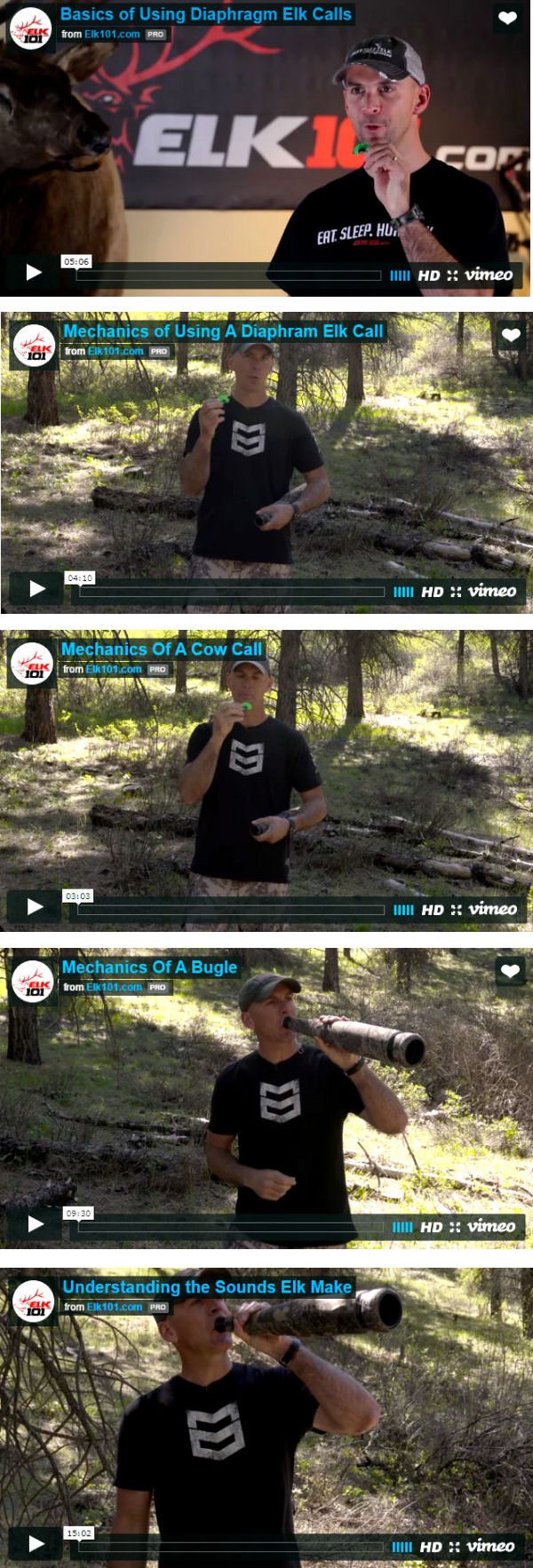 As you know, I am an engineer, so everything gets laid out in a very linear, simple process that can be easily replicated by anyone. The step-by-step calling videos start out at the very basics of showing you how to make sounds the right way with a diaphragm. Then, I show you how to correctly control the sounds you are making…and both of these videos come before we even start working on actual elk sounds!
As you know, I am an engineer, so everything gets laid out in a very linear, simple process that can be easily replicated by anyone. The step-by-step calling videos start out at the very basics of showing you how to make sounds the right way with a diaphragm. Then, I show you how to correctly control the sounds you are making…and both of these videos come before we even start working on actual elk sounds!
Then, we’ll jump into the mechanics of controlling the sounds to formulate a cow sound. Rather than have you listen to a cow sound and try to immediately replicate it – which is how most people learn to call – I break down the mechanics of what you are actually doing when you make a cow sound, and walk you through that process step by step. With it broken down at this level, you will be making perfect cow sounds within a matter of minutes! And then I do the same thing for bugles.
Bugles are actually very simple. And when you see the actual mechanics of what goes into making a bugle, it will click and you will be cranking out great sounding bugles right away. I’ll also demonstrate and explain the most common sounds elk make, and talk about what those sounds mean and which ones you need to be most interested in understanding and replicating.
Lastly, you’ll find a video of actual elk sounds – cows and bulls making cow calls and bugles that you can listen to over and over as you practice what you’ve learned.
If you struggle to use diaphragm elk calls, or you just want to become a better caller, this Module will walk you through everything in an easy to follow – and easy to replicate – process and have you confident in your calling abilities in no time! All of this information is included in Module 5: Using Elk Calls, and is completely separate from Module 9 which goes into GREAT detail on how to actually call elk in.
In Module 9, I’ll talk about 8 different calling strategies that will enable you to call in elk in just about any situation. I’ll also talk about several supplements that you can add to your calling tactics to increase your chances of calling an elk in close…and so much more!
If you’re ready to get signed up, Click Here Now
3. How can I overcome the wind and get closer to elk?
Wind is probably the greatest nemesis to an elk hunter. I would venture to say that more elk hunts have been blown by the wind (no pun intended) than by any other factor. So, it becomes vital to understand not only how thermals work in the mountains, but also how elk use the thermals – and their sense of smell – to avoid danger (you).
In Module 6: Elk Hunting Knowledge, you’ll find a detailed look at the life of an elk beginning at the birth of the calves in late spring and walking through every event in an elk’s life throughout the year (calving, summer grounds, pre-rut, rut, post-rut, late season, winter, etc.). I’ll also talk a lot about an elk’s senses, and how they use their senses to stay alive throughout the year.
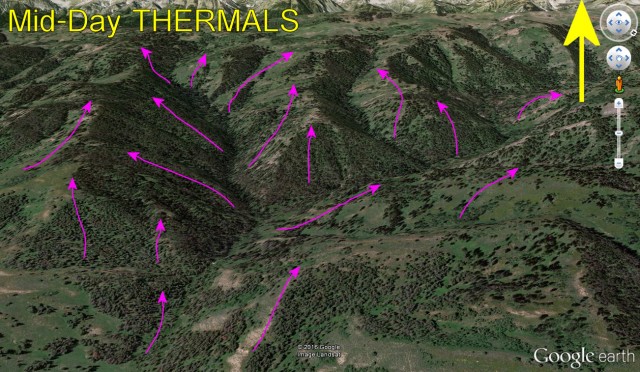 From there, I break down the day in a life of an elk, and talk about daily elk habits – what they are doing, and more importantly, why they are doing it. Then, I dive deep into the subject of thermals….when, why, and how to use them to your advantage to get close to elk.
From there, I break down the day in a life of an elk, and talk about daily elk habits – what they are doing, and more importantly, why they are doing it. Then, I dive deep into the subject of thermals….when, why, and how to use them to your advantage to get close to elk.
Later on, in Module 8: Setting Up On Elk, I bring all of this information back and share how you can use thermals to efficiently set up on elk so they aren’t able to use their sense of smell to detect your presence.
Understanding the wind, and understanding how the elk use the wind to stay alive, is a key component to overcoming the limiting effects of the wind and not allowing it to spoil your hunts. And that component is covered in great detail in the Online Course.
You can sign up for the Online Course now by Clicking Here
4. Elk Anatomy and Following the Bloodtrail
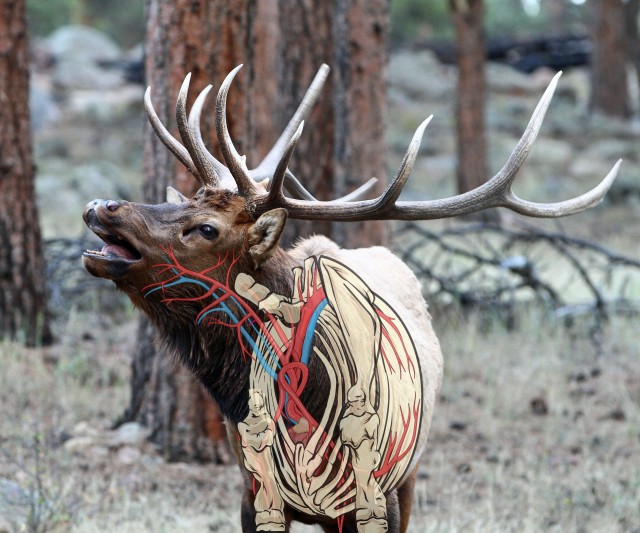 One of the topics that quickly became my favorite as I was creating the Online Course is the detailed explanation of elk anatomy – where the vitals and veins/arteries lie, how the bone structure protects the vitals, and where you need to aim to make the most efficient shot.
One of the topics that quickly became my favorite as I was creating the Online Course is the detailed explanation of elk anatomy – where the vitals and veins/arteries lie, how the bone structure protects the vitals, and where you need to aim to make the most efficient shot.
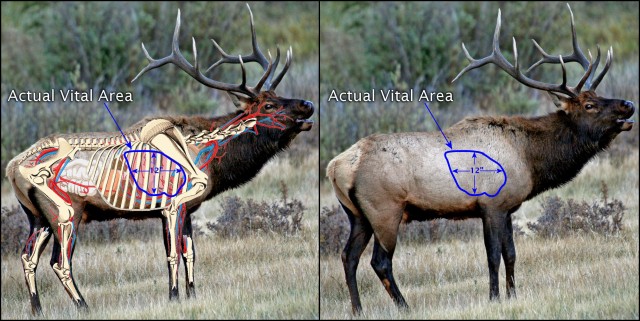 I spent a day dissecting a full elk carcass in a controlled, cleanroom environment where I could take my time and measure multiple features, as well as weigh every part of the elk. With this information, I created new, detailed overlay diagrams of the elk anatomy showing all of these features for both a broadside shot and a frontal shot. You will definitely want to see the images of the elk carcass from the front and educate yourself on how big the “opening” really is, as well as where it actually sits.
I spent a day dissecting a full elk carcass in a controlled, cleanroom environment where I could take my time and measure multiple features, as well as weigh every part of the elk. With this information, I created new, detailed overlay diagrams of the elk anatomy showing all of these features for both a broadside shot and a frontal shot. You will definitely want to see the images of the elk carcass from the front and educate yourself on how big the “opening” really is, as well as where it actually sits.
Another interesting feature is the actual vital area on a broadside shot. You’ll see the “void” elk hunters often reference when they hit a little high, and get a complete understanding of where you need to hit, and what the outcome will likely be if you hit in certain areas.
Summary
I know, this is a ton of information, and I only scratched the surface in this article explaining less than 15% of the topics that are covered in the Online Course. But I want you to get a good feel for the level of detail that is included within the Course in every imaginable elk hunting topic. There are no stones left unturned, and no way you won’t become a better elk hunter by participating in the Course.
By signing up now, you’ll save $50 (!) and have full access to all the content within the Course for the next year. That means you can come back time and time again and re-read, re-watch, and re-learn the information. A minimal investment in yourself will pay dividends this fall, and for the rest of your life. If you’re ready to get started, just click the banner below and take advantage of the $49 introductory rate before it goes back to the standard price of $99 next week (June 8th).
If you have specific questions about what is covered in the course, feel free to post them in the comments section below, and I’ll do my best to answer all of the questions. Thanks, and happy elk hunting!

